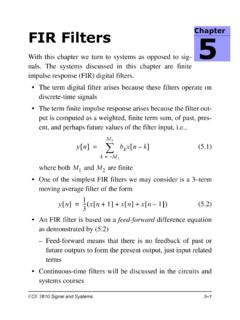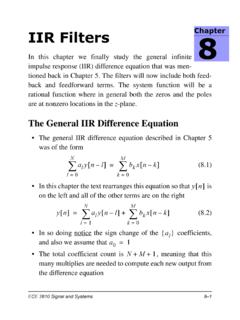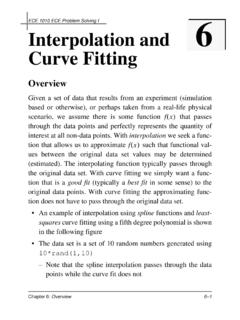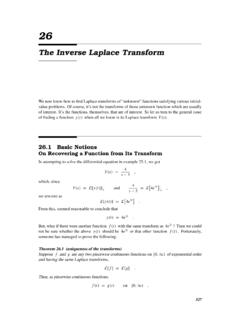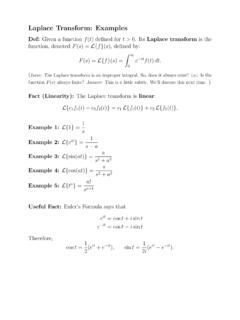Transcription of z-Transforms Chapter 7
1 ECE 2610 Signal and Systems7 1z-TransformsIn the study of discrete-time signal and systems, we have thus farconsidered the time-domain and the frequency domain. The z-domain gives us a third representation. All three domains arerelated to each other. A special feature of the z- transform is that for the signalsand system of interest to us, all of the analysis will be in terms ofratios of polynomials. Working with these polynomials is rela-tively straight of the z- transform Given a finite length signal , the z- transform is definedas( )where the sequence support interval is [0, N], and z is anycomplex number This transformation produces a new representation of denoted Returning to the original sequence (inverse z- transform ) requires finding the coefficient associated with the nth powerof xn[]Xz()xk[]zk k0=N xk[]z1 ()kk0=N ==xn[]Xz()
2 Xn[]z1 Chapter7 Definition of the z-TransformECE 2610 Signals and Systems7 2 Formally transforming from the time/sequence/n-domain tothe z-domain is represented as A sequence and its z- transform are said to form a z-transformpair and are denoted( ) In the sequence or n-domain the independent variable is n In the z-domain the independent variable is zExample: Using the definition Thus,n-Domainz-Domain xn[]xk[] nk []k0=N Xz() xk[]zk k0=N ==zzxn[]Xz() zxn[] nn0 []=Xz()xk[]zk k0=N kn0 []zk k0=N zn0 === nn0 []zn0 zThe z- transform and Linear SystemsECE 2610 Signals and Systems7 3 Example: By inspection we find thatExample: By inspection we find that What can we do with the z- transform that is useful?
3 The z- transform and Linear Systems The z- transform is particularly useful in the analysis anddesign of LTI systemsThe z- transform of an FIR Filter We know that for any LTI system with input andimpulse response , the output is( ) We are interested in the z- transform of , where for anFIR filter( )xn[]2 n[]3 n1 []5 n2 []2 n3 []+++=Xz()23z1 5z2 2z3 +++=Xz()45z2 z3 2z4 + =xn[]4 n[]5 n2 [] n3 []2 n4 [] +=xn[]hn[]yn[]xn[]*hn[]=hn[]hn[]bk nk []k0=M =The z- transform and Linear SystemsECE 2610 Signals and Systems7 4 To motivate this, consider the input( ) The output is( ) The term in parenthesis is the z- transform of , alsoknown as the system function of the FIR filter Like was defined in Chapter 6, we define the systemfunction as( ) The z- transform pair we have just established is Another result, similar to the frequency response result, is( )xn[]zn n <<,=yn[]yn[]bkxnk []k0=M bkznk k0=M ==bkznzk k0=M bkzk k0=M zn==hn[]Hej ()Hz()bkzk k0=M hk[]zk k0=M ==hn[]Hz() bk nk []k0=M bkzk k0=M zzyn[]hn[]*znHz()
4 Zn==The z- transform and Linear SystemsECE 2610 Signals and Systems7 5 Note if , we in fact have the frequency responseresult of Chapter 6 The system function is an Mth degree polynomial in complexvariable z As with any polynomial, it will have M roots or zeros, that isthere are M values such that These M zeros completely define the polynomial to withina gain constant (scale factor), ,where denote the zerosExample: Find the Zeros of The z- transform iszej =z0Hz0()0=Hz()b0b1z1 ..bMzM +++=1z1z1 ()1z2z1 ()..1zMz1 ()=zz1 ()zz2 ()..zzM ()zM------------------------------------ --------------------------=zkk, ,,=hn[] n[]16--- n1 []16--- n2 [] +=Hz()116---z1 16---z2 +=112---z1 + 113---z1 =z12---+ z13--- z2 =Properties of the z-TransformECE 2610 Signals and Systems7 6 The zeros of are -1/2 and +1/3 The difference equationhas the same zeros, but a different scale factor.
5 Proof:Properties of the z- transform The z- transform has a few very useful properties, and its def-inition extends to infinite signals/impulse responsesThe Superposition (Linearity) Property( )proofHz()yn[]6xn[]xn1 []xn2 [] +=ax1n[]bx2n[]+aX1z()bX2z()+ zXz()ax1n[]bx2n[]+()z1 n0= =ax1n[]z1 n0=N bx2n[]z1 n0=N +=aX1z()bX2z()+=Properties of the z-TransformECE 2610 Signals and Systems7 7 The Time-Delay Property( )and( )proof: ConsiderthenLetsoSimilarlyxn1 []z1 Xz() zxnn0 []zn0 Xz() zXz() 0 1z1 .. NzN +++=xn[] k nk []k0=N = 0 n[] 1 n1 [].. N nN []+++=Yz()z1 Xz()= 0z1 1z2 .. NzN 1 +++=yn[] 0 n1 [] 1 n2 [].. N nN1 []+++=xn1 []=Yz()zn0 Xz()= yn[] xnn0 []=The z- transform as an OperatorECE 2610 Signals and Systems7 8A General z- transform Formula We have seen that for a sequence having support inter-val the z- transform is( ) This definition extends for doubly infinite sequences havingsupport interval to( ) There will be discussion of this case in Chapter 8 when wedeal with infinite impulse response (IIR) filtersThe z- transform as an OperatorThe z- transform can be considered as an Operatorxn[]0nN Xz()xn[]zn n0=N = n Xz()
6 Xn[]zn n = =UnitDelayz1 xn[]xn[]yn[]xn1 []=The z- transform as an OperatorECE 2610 Signals and Systems7 9 In the case of the unit delay, we observe that( )which is motivated by the fact that Similarly, the filtercan be viewed as the operatorsinceExample: Two-Tap FIR Using the operator convention, we can write by inspectionthatyn[]z1 xn[]{}xn1 []==unit delay operatorYz()z1 Xz()=yn[]xn[]xn1 [] =yn[]1z1 ()xn[]{}xn[]xn1 [] ==Yz()Xz()z1 Xz() 1z1 ()Xz()==Yz()b0Xz()b1z1 Xz()+=yn[]b0xn[]b1xn1 []+=Convolution and the z-TransformECE 2610 Signals and Systems7 10 Convolution and the z- transform The impulse response of the unity delay system isand the system output written in terms of a convolution is The system function (z- transform of ) isand by the previous unit delay analysis, We observe that( )proof.
7 ( )We n ow t a ke t h e z- transform of both sides of ( ) usingsuperposition and the general delay property( )hn[] n1 []=yn[]xn[]* n1 []xn1 []==hn[]Hz()z1 =Yz()z1 Xz()=Yz()Hz()Xz()=yn[]xn[]*hn[]hk[]xnk []k0=M ==Yz()hk[]zk Xz()()k0=M =hk[]zk k0=M Xz()Hz()Xz()==Convolution and the z-TransformECE 2610 Signals and Systems7 11 Note: For the case of a finite duration sequence, isa polynomial, and is a product of polynomials inExample: Convolving Finite Duration Sequences Suppose that We wish to find by first finding We begin by z-transforming each of the sequences We find by direct multiplication We find using the delay property on each of the terms ofConvolve directly?
8 Xn[]Xz()Hz()Xz()z1 xn[]2 n[]3 n2 [] 4 n3 []+=hn[] n[]2 n1 [] n2 []++=yn[]Yz()Xz()23z2 4z3 +=Hz()12z1 z2 ++=Yz()Yz()23z2 4z3 +()12z1 z2 ++()=24z1 z2 2z3 5z4 4z5 +++=yn[]Yz()yn[]2 n[]4 n1 [] n2 [] +=2 n3 [] 5 n4 []4 n5 []++Convolution and the z-TransformECE 2610 Signals and Systems7 12 This section has established the very important result thatpolynomial multiplication can be used to replace sequenceconvolution, when we work in the z-domain, ,Cascading Systems We have seen cascading of systems in the time-domain andthe frequency domain, we now consider the z-domain We know from the convolution theorem that It also follows thatso by substitution( )yn[]hn[]*xn[]=Hz()Xz() Yz()=zz- transform Convolution TheoremWz()H1z()Xz()=Yz()H2z()Wz()=Yz()H 2z()H1z()[]Xz()
9 =H1z()H2z()[]Xz()=Convolution and the z-TransformECE 2610 Signals and Systems7 13 In summary, when we cascade two LTI systems, we arrive atthe cascade impulse response as a cascade of impulseresponses in the time-domain and a product of the z-trans-forms in the z-domainFactoring z-Polynomials Multiplying z-Transforms creates a cascade system, so factor-ing must create subsystemsExample: Since is a third-order polynomial, we should be able tofactor it into a first degree and second degree polynomial We can use the MATLAB function roots() to assist us>> p = roots([1 3 -2 1])p = + - >> conv([1 -p(2)],[1 -p(3)])ans = - With one real root, the logical factoring is to create two poly-nomials as followshn[]h1n[]*h2n[]=H1z()H2z() Hz()=zHz()13z1 2z2 z3 ++=Hz()Convolution and the z-TransformECE 2610 Signals and Systems7 14 The cascade system is thus.
10 As a check we can multiply the polynomials>> conv([1 -p(1)],conv([1 -p(2)],[1 -p(3)]))ans = , , , The difference equations for each subsystem areDeconvolution/Inverse Filtering In a two subsystems cascade can the second system undo theaction of the first subsystem? For the output to equal the input we need We thus desire or H1z() +=H2z() +()z1 ()= ()z1 ()1 += +1 +H1z()H2z()xn[]wn[]yn[]Xz()Wz()Yz()wn[]x n[] []+=yn[]wn[] [] []+=Hz()1=H1z()H2z()1=H2z()1H1z()------- -------=Convolution and the z-TransformECE 2610 Signals and Systems7 15 Example: The inverse filter is This is no longer an FIR filter, it is an infinite impulseresponse (IIR) filter, which is the topic of Chapter 8 We can approximate as an FIR filter via long division An term approximation is Recall the deconvolution filter of Lab 8?

